Folding tables for a small kitchen: advantages and disadvantages, varieties and tips for choosing

It is quite difficult to furnish a small kitchen, since it is imperative to put everything you need in it and at the same time make the arrangement as convenient as possible. The most difficult thing is with large items, in particular, with a table. In this case, it is better to pay attention to the folding models, with which you can easily organize even a small kitchen space.
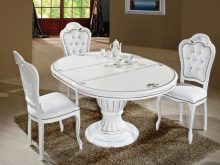
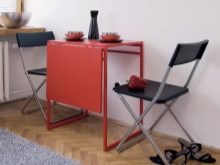
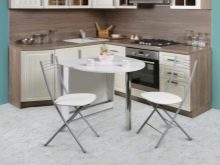
Peculiarities
The table in the kitchen performs several functions at once:
- it is necessary for comfortable placement during meals;
- can be used as an additional surface for cooking;
- its surface (as well as additional drawers or niches) can serve as a place for storing kitchen utensils;
- like any other furniture, it decorates the room, creates the desired mood.
If there is no other place in the apartment, a laptop, school notebooks, books, handicrafts, etc. are often found on the kitchen table. Therefore, the corresponding requirements are imposed on it: strength, durability, wear resistance, ergonomics and convenience.
But the main thing is the ability to change the size according to the situation. An ideal solution in this case would be a folding table.
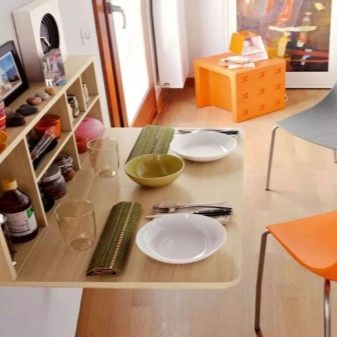
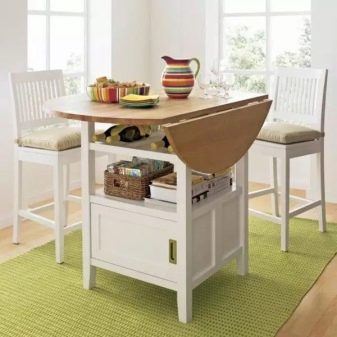
It usually has three main parts:
- Covers. When folded, depending on the design, it consists of one or two canvases (tabletops). Then an additional part is attached to it.
- Supports (legs). Not only the appearance and convenience, but also the stability of the product depends on their number, thickness and shape.
- Underframe, with the help of which the shape and dimensions of the table can be changed.
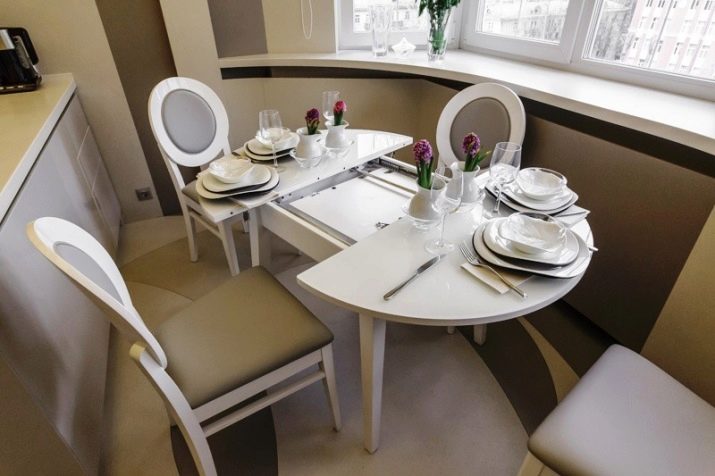
Advantages and disadvantages
Among the strengths of the folding table the following characteristics can be distinguished.
- Multifunctionality - if necessary, he can be lunch, butcher or even work.
- Adaptability - when folded, it is quite compact, but the working area of the tabletop can be changed if necessary. Even small families should have such a table, because guests can always come.
- Ergonomic Even when unfolded, it is comfortable to sit behind it.
- Variability - the choice of materials, colors and shapes of such tables is wide enough.
- Saving space in a small room. In extreme cases, when folded, it is easy to move it to another room and spread it out there.
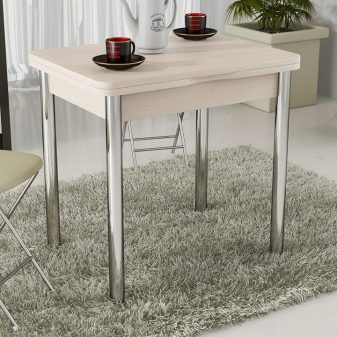

The disadvantages of folding tables lie in the peculiarities of their designs and the complexity of the folding mechanism. After all, pushing some models apart requires not only time, but considerable effort. Fortunately, this is rather the exception. Most sliding systems are well thought out and function easily.
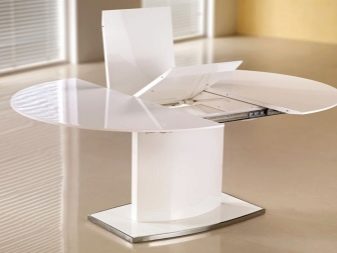
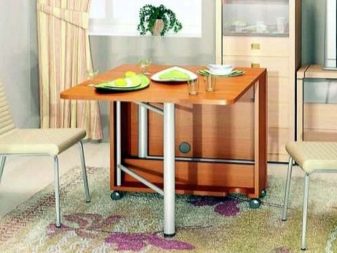
Types of structures
Any table that can change its size is a complex structure. Depending on this, several main types can be distinguished.
Folding - one of the largest groups. The mechanisms used here can vary in complexity. The simplest option is a two-layer tabletop connected by hinges. More complex ones - with a turning part. It is better if the mechanism is synchronized, when the impact on one part sets in motion all the others. So the unfolding happens with lightning speed and without unnecessary movements.

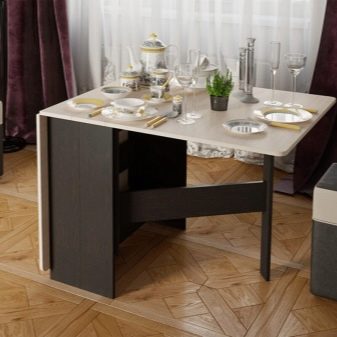
Sliding are subdivided into:
- models in which the changes concern only the area of the table (mainly with the help of guides);
- tables with the ability to move legs (more reliable option for long models).

Retractable - in them, the table top can be pulled out of existing furniture (for example, from under the countertop of a kitchen unit), a window sill or a wall.


Folding - are a type of folding. Their design implies the presence of one or two additional tabletops on the side, which can be easily raised or lowered. For a small kitchen, the best option is a table, one of the supports of which is a wall - when folded, it will be almost invisible. The same principle is used in well-known book tables and their modifications.
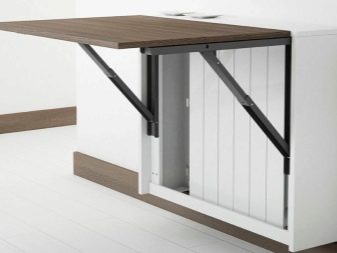
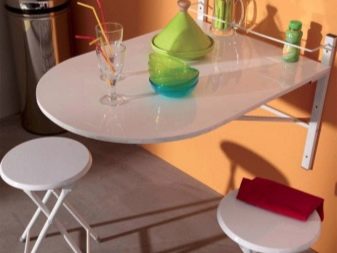
Transformers - it is customary to understand them as those models that can change not only the width, but also the height. This is especially convenient for kitchens combined with a living room, because a full dining table can be turned into a compact coffee table at any time.
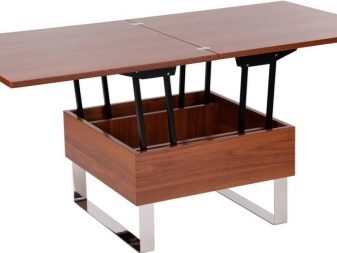
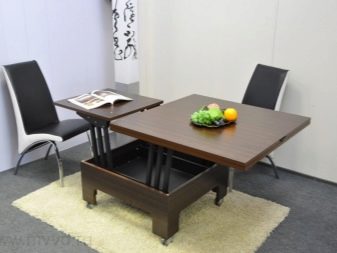
Dimensions (edit)
Selecting a table size depends on two factors:
- kitchen space;
- the number of people who need to be accommodated in everyday life and in special situations.
In the first case, in addition to the table and chairs with people sitting on them, you need to take into account the space for passages to the stove, refrigerator and sink. The distance between the table and the kitchen set should be at least 60 cm. In the second case, it is important to observe the comfort of the seated person. For eating, each person needs a space of at least 40 cm wide. This is necessary not only for comfort, but also to avoid awkward situations, since all hand movements will be constrained.
The standard size of a table around which a small family can fit is 60x80 cm.There are also more compact models - 50x50 and 60x60 cm.

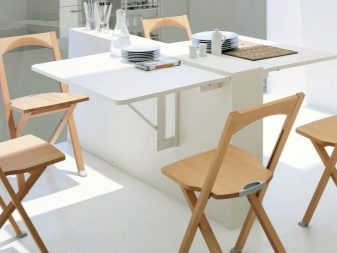
When folded, at such a modest tabletop, you will have to take turns eating. But this solution is ideal for narrow kitchens. When unfolded, such tables increase by 30, 40 cm or even double. A special place is occupied by models with a round table top with a folding mechanism. It is difficult to find them with a diameter of less than 85 or 90 cm, and they increase to 115 and 120 cm, respectively. In this case, the shape of the table changes to oval.
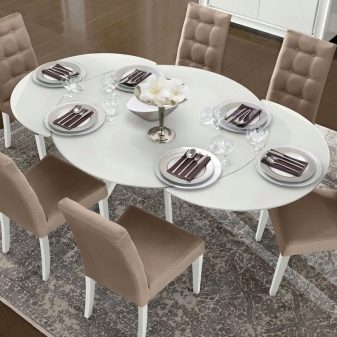
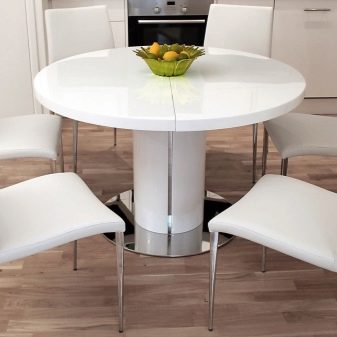
Materials (edit)
The legs and table top are usually made from different materials. For supports, strength is first of all important, and only then - appearance. Therefore, the following materials are most often used here.
- Metal. The toughest material. Metal legs and base can be chrome, matt or painted.
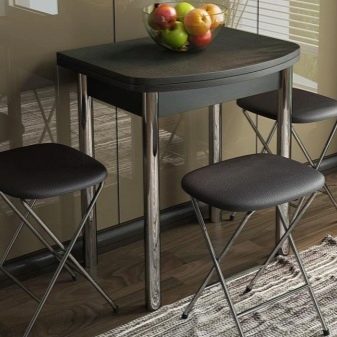
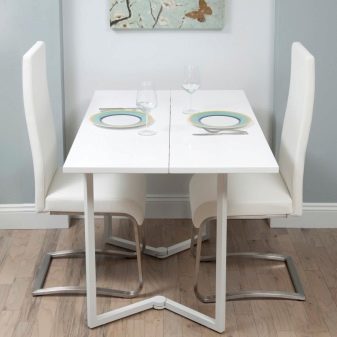
- Wood. The hard rock mass is quite reliable. A good moisture-resistant coating guarantees durability and makes it easier to maintain furniture. The undoubted advantage is the respectable appearance and environmental friendliness of the product.


- MDF. The veneer coating in appearance is practically not inferior to solid wood, but it is a more affordable option. MDF with a film coating is more practical - an affordable price and resistance to moisture speaks in its favor. Such a table can be either multi-colored or in woody tones with an imitation of the corresponding texture. Such a coating is easy to damage, therefore, with a careless attitude, it quickly loses its gloss.


- Chipboard. Its properties are similar to MDF, but its appearance is usually assessed as less presentable. Despite the average wear resistance, it is one of the most popular and economical varieties.
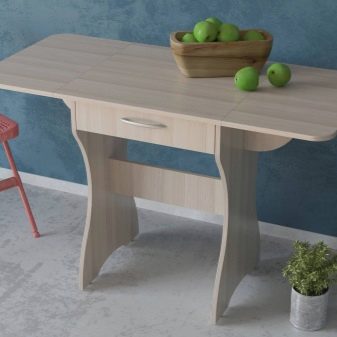

For the table top (table top), in addition to the above materials, tempered glass, stone or ceramic inserts can be used.
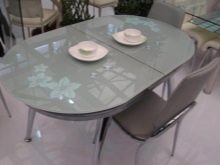
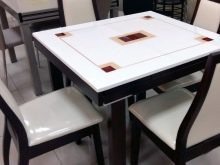
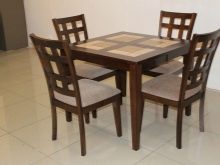
Color solution
First of all, the table should not seem like a foreign object in the interior of the kitchen. In the design of the room, it is better not to use more than three matching colors. In this case, the color of the table should be one of them. Generally, furniture should be selected even at the stage of planning the repair - in this case, the color of the model you like can be coordinated with the covering of walls, floors, doors, household appliances... Also, a lot depends on the material of the table. For example, solid wood or veneer have their own special palette. Of course, wooden furniture can be painted, but it is natural shades that are considered the most pleasant for human perception.
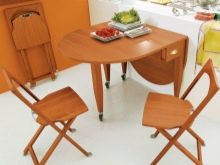


Since we are talking about a small kitchen, it is important to place accents correctly in it. Despite the size, the dining area can be made central. To do this, you should opt for yellow, olive, blue or green - they are bright enough, promote appetite and look unobtrusive. Moreover, they try to make the rest of the furniture neutral in order to visually expand the boundaries of the room. The same technique can be carried over to the dining area. In order not to draw attention to the most voluminous part of the table - the lid, it is often ordered in white or beige.
Even the most bulky structure can be lightened with a glass surface. In addition, cutlery accessories (cutlery, napkins and dishes) will look more advantageous against such a background.
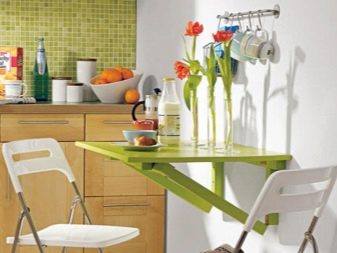

How to choose?
Usually the process of choosing a table takes a lot of time. Of course, you can haphazardly browse catalogs or exhibition samples, but it is better to determine the required characteristics at the initial stage.
- First you need to figure out the size. To do this, measure the room and allocate space for the table in it. It is important to calculate the maximum possible sizes (both folded and unfolded) and choose within them. Not all manufacturers make custom furniture. Even in the unfolded state, the transformer must maintain its stability.
- In a house with active household members (including children), the table should be as practical as possible - here it is important not to be mistaken with the material. The surface of the lid should be non-marking and easy to clean.
- The complexity of the mechanism depends on how often the need for unfolding arises. It should be simple and well-debugged. Here you also need to pay attention to the weight of those parts to which you will have to make efforts.
- The shape of the table and its legs are of great importance.A rectangular and square table is easier to place in a corner or near a wall, while a round or oval table can accommodate more guests. Legs should not interfere with a comfortable position at the table.
Do not forget about chairs - they also need to be allocated space. In a small kitchen, it is better to refuse bulky chairs or sofas. The optimal solution is small stools, folding or stackable models.
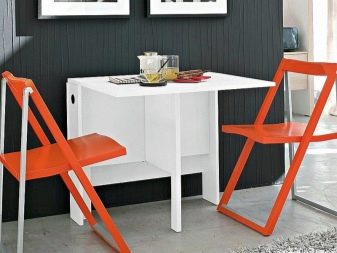
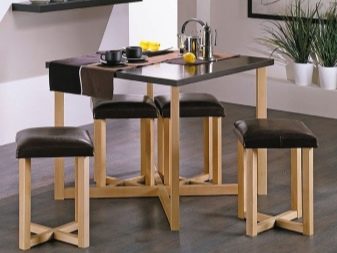
Interesting examples
Despite the fact that for a small kitchen the possibility of increasing the size must be combined with compactness, the choice in this category is quite diverse. You can choose a "semi-antique" model with smooth lines, carved legs, a lot of decorative details. A wooden table close to this option is suitable for a kitchen that has embodied the charm of a rustic style.
A special atmosphere is evoked by furniture, which has left external imprints on it - scuffs, cracks.
Shabby chic furnishings allow you to be creative, because you can create signs of artificial aging yourself.

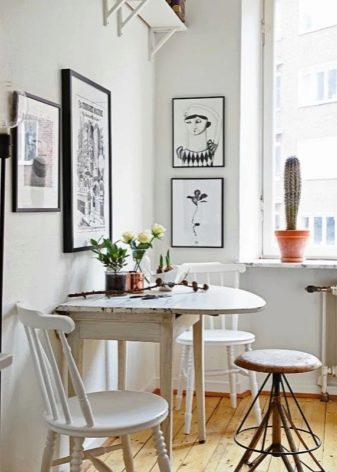
A similar softness and comfort can be found in more modern directions. This is especially true for modernity. There are not many decorations in it, elegance and grace are in the foreground. In contrast to it, ultra-fashionable high-tech acts - here you can feel swiftness and clarity in everything. The sliding and folding mechanisms emphasize the technical component. The decor of such a table will be restrained; best of all, its character will emphasize the shine of metal and glass. Minimalism is no less relevant for modern times - everything is laconic and practical here. This manifests itself both in color and in the texture of the material.

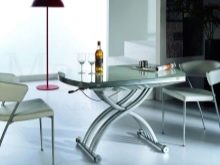
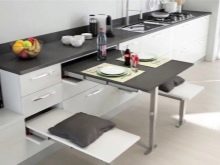
Below you can watch a video with options for dining tables for a small kitchen.








